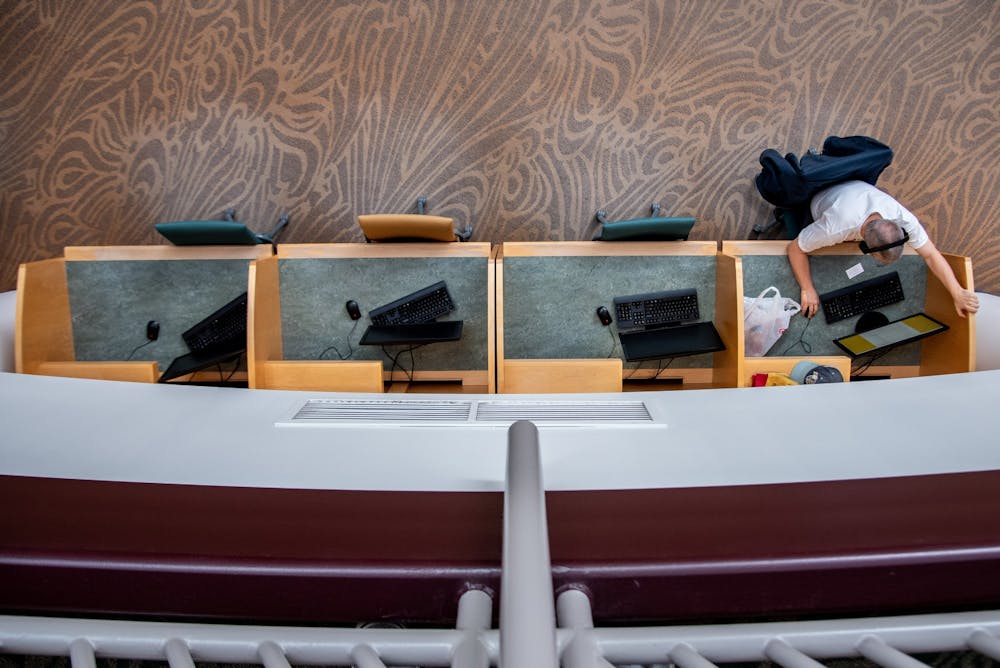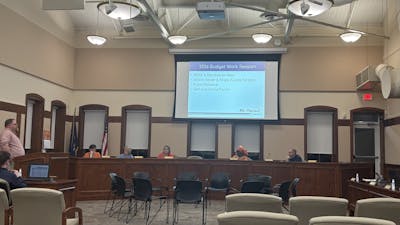Fall classes set to follow Hyflex teaching method

Empty seats accompany someone using the computers at Charles V. Park Library March 17 on campus. The Charles V. Park Library originally remained open despite classes being moved online.
While Central Michigan University's campus will be open for face-to-face instruction amid the COVID-19 pandemic, classes be conducted differently than what students are used to.
For the fall semester, classes will follow a Hyflex course design.
In the Hyflex design model, students have control over their classroom experience. They can choose to attend face-to-face classes or complete the course learning activities online without physically attending class.
“The premise of Hyflex is really some flexibility with a socially-distanced class for students to come in, as well as individuals who, for whatever reason, choose to access the class remotely at the same time,” Provost Mary Schutten said. “We’re trying to preserve what makes CMU the place you wanted to come. I’ve heard lots of great excitement from students about being back at campus for classes, regardless of what that may entail.”
The Hyflex teaching method allows professors to provide a face-to-face and online classroom experience to support student learning, according to Brian Beatty, Associate Professor of Instructional Technologies at San Francisco State University.
“A continuous challenge for instructors is ensuring that students are engaged in a single learning community regardless of their participation mode,” Beatty said.
Beatty specialized in the first development of Hybrid-Flexible learning environments at SFSU and implemented a student-directed approach to better support student learning. He published the book “Hybrid-Flexible Course Design: Implementing student-directed hybrid classes” to help other teachers moving to a Hyflex course structure.
Instructors are responsible for making sure that every student in the class, whether they’re online or in person, is engaged with the instructor and the rest of the class and are fully participating in the course activities and lectures.
Jiafei Yin teaches journalism in a lab-style classroom. Recently, two more computer stations were added at the back of that classroom. Yin said that it is difficult to walk around the room in general, let alone six feet apart from one another.
“I feel a lot of anxiety about introducing Hyflex, not because it is a new teaching format, but because the university hasn’t established clear standards and protocols about a safe face-to-face teaching like social distancing, taking temperatures and lab equipment cleaning," Yin said. “Anxious minds cannot teach, or learn, well.”
The Hyflex model includes two kinds of online instruction. Online synchronous instruction is a one-on-one presentation that is similar to a face-to-face class, except the class is live-streamed or recorded and posted online for student viewers. Online asynchronous instruction differs in that teachers provide instructional content to students in many formats such as websites, videos, podcasts or simulations.
Schutten said during the June 24 Board of Trustees meeting that this fall CMU will be using a synchronous Hyflex method to maintain a face-to-face experience for both remote and in-class students. Cameras will be placed in classrooms to offer live streams of classes to remote students.
In order to maintain social distancing guidelines, a subset of students enrolled in a class will watch the lecture remotely while other students will physically come into class on any given day.
The university is working on floor plans for every possible teaching environment to ensure social distancing guidelines.
“As it stands right now, our classrooms are not equipped to handle this new format," said Ben Salisbury, a mathematics faculty member. "Moreover, it’s not clear that faculty will get the opportunity to go in and get hands-on practice with any new technology before classes start.
"I think the first few weeks of the new format are going to be bumpy.”
Salisbury is in the high-risk categories as defined by the CDC, so he is looking for the accommodation to move his class entirely online. However, Salisbury believes that online teaching may be a better format for his courses.
“Having everyone at a remote location for every class will help maintain consistency," Salisbury said. "No matter how it is ultimately delivered, my class will be a lecture format. Students will still be able to see me, see the board, and ask questions in real time."
A concern raised by some students on social media is that Hyflex will hinder their ability to interact with their instructors and classmates.
“As someone who’s trying to get into grad school too, being able to talk to professors and get to know them is important not only for advice on how to succeed, but to get letters of reference too,” Saginaw senior Hannah Benemann said.
In-class instructors were forced to quickly learn online teaching when campus closed due to COVID-19 halfway through the Spring 2020 semester. It was a challenging time for faculty and students as instructors trashed their course schedules and started fresh during the online transition.
Many students have said they are grateful that CMU is adopting Hyflex courses, whether it’s because they are high-risk for COVID-19 or just have added stressors in their life such as mental health or financial struggles due to the pandemic.
“I feel that our faculty and staff easily transitioned from face-to-face to remote learning last semester and with Hyflex training in place, this will be an easy and beneficial transition for faculty and students,” Clarkston senior Hannah Robertson said.
The Office of Curriculum and Instructional Support has created a Hyflex page in which there are several informational and instructional videos on Hyflex courses for students who may be struggling in this new environment.






